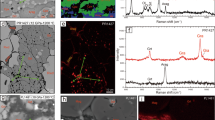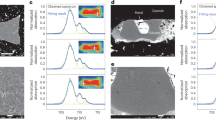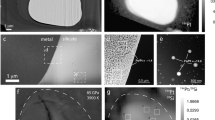Abstract
The oxygen fugacity of the Earth’s mantle is one of the fundamental variables in mantle petrology. Through ferric–ferrous iron and carbon–hydrogen–oxygen equilibria, influences the pressure–temperature positions of mantle solidi and compositions of small-degree mantle melts1,2,3. Among other parameters, affects the water storage capacity and rheology of the mantle4,5. The uppermost mantle, as represented by samples and partial melts, is sufficiently oxidized to sustain volatiles, such as H2O and CO2, as well as carbonatitic melts6,7, but it is not known whether the shallow mantle is representative of the entire upper mantle. Using high-pressure experiments, we show here that large parts of the asthenosphere are likely to be metal-saturated. We found that pyroxene and garnet synthesized at >7 GPa in equilibrium with metallic Fe can incorporate sufficient ferric iron that the mantle at >250 km depth is so reduced that an (Fe,Ni)-metal phase may be stable. Our results indicate that the oxidized nature of the upper mantle can no longer be regarded as being representative for the Earth’s upper mantle as a whole and instead that oxidation is a shallow phenomenon restricted to an upper veneer only about 250 km in thickness.
This is a preview of subscription content, access via your institution
Access options
Subscribe to this journal
Receive 51 print issues and online access
$199.00 per year
only $3.90 per issue
Buy this article
- Purchase on Springer Link
- Instant access to full article PDF
Prices may be subject to local taxes which are calculated during checkout




Similar content being viewed by others
References
Taylor, W. R. & Green, D. H. in Magmatic Processes: Physicochemical Principles (ed. Mysen, B. O.) 121–138 (Geochemical Society USA Special Publication 1, University Park, Pennsylvania, 1987)
Ballhaus, C., Berry, R. F. & Green, D. H. Oxygen fugacity controls in the Earth's upper mantle. Nature 348, 437–440 (1990)
Dasgupta, R. & Hirschmann, M. M. Melting in the Earth's deep upper mantle caused by carbon dioxide. Nature 440, 659–662 (2006)
Kohlstedt, D. L., Keppler, H. & Rubie, D. C. Solubility of water in the alpha, beta and gamma phases of (Mg,Fe)2SiO4 . Contrib. Mineral. Petrol. 123, 345–357 (1996)
Keppler, H. & Rauch, M. Water solubility in nominally anhydrous minerals measured by FTIR and 1H MAS NMR; the effect of sample preparation. Phys. Chem. Miner. 27, 371–376 (2000)
Matveev, S., Ballhaus, C., Fricke, K., Trunckenbrodt, J. & Ziegenbein, D. CHO volatiles under upper mantle conditions. I. Experimental results. Geochim. Cosmochim. Acta 61, 3081–3088 (1997)
Wallace, M. E. & Green, D. H. An experimental determination of primary carbonatite magma composition. Nature 335, 343–346 (1988)
Frost, B. R. in Oxide Minerals; Petrologic and Magnetic Significance (ed. Lindsley, D. H.) 1–9 Reviews in Mineralogy (ed. Ribbe, P. H.) Vol. 25 (Mineralogical Society of America, Washington DC, 1991)
O'Neill, H. St. C. The origin of the Moon and the early history of the Earth – A chemical model. Part 2: The Earth. Geochim. Cosmochim. Acta 55, 1159–1172 (1991)
Luth, R. W., Virgo, D., Boyd, F. R. & Wood, B. J. Ferric iron in mantle-derived garnets. Contrib. Mineral. Petrol. 104, 56–72 (1990)
Ballhaus, C., Berry, R. F. & Green, D. H. Experimental calibration of the olivine–orthopyroxene–spinel oxygen barometer—implications for oxygen fugacity in the Earth's upper mantle. Contrib. Mineral. Petrol. 107, 27–40 (1991)
Wood, B. J., Bryndzia, L. T. & Johnson, K. E. Mantle oxidation state and its relationship to tectonic environment and fluid speciation. Science 248, 337–345 (1990)
Ballhaus, C. Is the upper mantle metal-saturated? Earth Planet. Sci. Lett. 132, 75–86 (1995)
Woodland, A. B. & Koch, M. Variation in the oxygen fugacity with depth in the upper mantle beneath the Kaapvaal craton, Southern Africa. Earth Planet. Sci. Lett. 214, 295–310 (2003)
Palme, H. & O'Neill, H. St. C. in The Mantle and Core (ed. Carlson, R. W.) 1–38 Treatise on Geochemistry (eds Holland, H. D. & Turekian K. K.) Vol. 2 (Elsevier–Pergamon, Oxford, 2003)
van Aken, P. A. & Liebscher, B. Quantification of ferrous/ferric ratios in minerals: new evaluation schemes of Fe L23 electron energy-loss near-edge spectra. Phys. Chem. Miner. 29, 188–200 (2002)
van Aken, P. A., Liebscher, B. & Styrsa, V. J. Quantitative determination of iron oxidation states in minerals using Fe L2,3-edge electron energy-loss near-edge structure spectroscopy. Phys. Chem. Miner. 25, 323–327 (1998)
Irifune, T. An experimental investigation of the pyroxene–garnet transformation in a pyrolite composition and its bearing on the constitution of the mantle. Phys. Earth Planet. Inter. 45, 324–336 (1987)
Canil, D. & O'Neill, H. St C. Distribution of ferric iron in some upper-mantle assemblages. J. Petrol. 37, 609–635 (1996)
O'Neill, H. St C. et al. Mössbauer spectroscopy of mantle transition zone phases and determination of minimum Fe3+ content. Am. Mineral. 78, 456–460 (1993)
Frost, D. J. et al. Experimental evidence for the existence of iron-rich metal in the Earth's lower mantle. Nature 428, 409–412 (2004)
Wade, J. & Wood, B. J. Core formation and the oxidation state of the Earth. Earth Planet. Sci. Lett. 236, 78–95 (2005)
Sinmyo, R., Hirose, K., O'Neill, H. St. C. & Okunishi, E. Ferric iron in Al-bearing post-perovskite. Geophys. Res. Lett. 33 L12S13 doi: 10.1029/2006GL025858 (2006)
McCammon, C. A. & Ross, N. L. Crystal chemistry of ferric iron in (Mg,Fe)(Si,Al)O3 majorite with implications for the transition zone. Phys. Chem. Miner. 30, 206–216 (2003)
Ringwood, A. E. Origin of chondrites. Nature 207, 701–704 (1965)
Meisel, T., Walker, R. J. & Morgan, J. W. The osmium isotopic composition of the Earth's primitive upper mantle. Nature 383, 517–520 (1996)
Jones, J. H. & Drake, M. J. Geochemical constraints on core formation in the Earth. Nature 322, 221–228 (1986)
Eggler, D. H. & Baker, D. R. in High Pressure Research in Geophysics (eds Akimoto, S. & Manghnani, M. H.) 237–250 (Center Academic, Tokyo, 1982)
Jacobs, D. E., Kronz, A. & Viljoen, K. S. Cohenite, native iron and troilite inclusions in garnets from polycrystalline diamond aggregates. Contrib. Mineral. Petrol. 146, 566–576 (2004)
Stachel, T., Harris, J. W. & Brey, G. P. Rare and unusual mineral inclusions in diamonds from Mwadui, Tanzania. Contrib. Mineral. Petrol. 132, 34–47 (1998)
Bellis, A. J. & Canil, D. Ferric iron in CaTiO3 perovskite as an oxygen barometer for kimberlitic magmas. I: Experimental calibration. J. Petrol. 48, 219–230 (2007)
Canil, D. & Bellis, A. J. Ferric iron in CaTiO3 perovskite as an oxygen barometer for kimberlite magmas. II: Applications. J. Petrol. 48, 231–252 (2007)
Acknowledgements
We thank the Museum of Natural History in London for providing Karoo picrite samples from Malawi. Comments on the manuscript by R. Frost and D. Canil and D. Frost improved the paper. Financial support by the German Research Council to C.B. is gratefully acknowledged.
Author information
Authors and Affiliations
Corresponding authors
Ethics declarations
Competing interests
Reprints and permissions information is available at www.nature.com/reprints.
Supplementary information
Supplementary Information
The file contains Supplementary Discussion with additional references; Supplementary Figure S1 with Legend and Supplementary Table S1. Supplementary Discussion uses Karoo picrites from southern Malawi to discuss the possibility that melts from metal–saturated sources can be recognized by their olivine compositions. Supplementary Fig. S1 shows the NiO contents and Ni/Co atomic ratios of olivines in the Karoo picrite sample. The Supplementary Table S1 lists the starting composition, run conditions and representative electron microprobe analyses of the run products. Details about electron microprobe and EELS measurements are given in the legend. (PDF 295 kb)
Rights and permissions
About this article
Cite this article
Rohrbach, A., Ballhaus, C., Golla–Schindler, U. et al. Metal saturation in the upper mantle. Nature 449, 456–458 (2007). https://doi.org/10.1038/nature06183
Received:
Accepted:
Issue Date:
DOI: https://doi.org/10.1038/nature06183
This article is cited by
-
The Fe(Ni)–C–N-phase diagram at 10 GPa—implications for nitrogen and carbon storage in the deep mantle
Contributions to Mineralogy and Petrology (2024)
-
Genesis and evolution of kimberlites
Nature Reviews Earth & Environment (2023)
-
Imperfections in natural diamond: the key to understanding diamond genesis and the mantle
La Rivista del Nuovo Cimento (2023)
-
The mantle structure below petit-spot volcanoes
Communications Earth & Environment (2022)
-
Subduction-related oxidation of the sublithospheric mantle evidenced by ferropericlase and magnesiowüstite diamond inclusions
Nature Communications (2022)
Comments
By submitting a comment you agree to abide by our Terms and Community Guidelines. If you find something abusive or that does not comply with our terms or guidelines please flag it as inappropriate.



